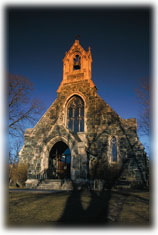![]()
Main Menu ·
Search ·
Current Issue · Contact · Archives · Centennial · Letters to the Editor · FAQs
![]()
Main Menu ·
Search ·
Current Issue · Contact · Archives · Centennial · Letters to the Editor · FAQs
Chapel Cliff-hanger Saved? An apartment tower was proposed. DAVID CARMACK |
At the corner of Kirkland and Quincy Streets stands the small stone Swedenborg Chapel. Johnny Appleseed was a Swedenborgian, as was William James, whose eponymous social-science tower across the street dwarfs the chapel today.
The Design School's Gund Hall rises on the other side. In February, a developer bid $2.7 million for the building and the small parcel of land it sits on. Therein lies a tale of town-gown relations.
The developer proposed to erect a residential apartment building between eight and 11 stories high. The neighbors, who had just battled Harvard over the siting of the Knafel Center for Government and International Affairs on the same block (see "Knafel Reconceived," January-February 1999, page 66), rallied again against the new foe. This time, Harvard was an ally.
The chapel is owned by the Swedenborg School of Religion, in Newton, Massachusetts. The chapel's congregation, which has the right of first refusal following an offer on the property, vehemently opposes the school's wish to sell; they cannot match the developable price of the property, but say they can pay if it is valued as a church. Harvard, which purchased much of the block from the School of Religion in the 1960s, negotiated a second right of refusal on the chapel property at that time. (University officials have said in the past that they have no interest in buying the church while the congregation retains the legal right to remain in it.)
A pitched battle between the congregation and the Swedenborg School seemed imminent when city councilors approved the Cambridge Historical Commission's recommendation to landmark the 1901 chapel. That means the four exterior walls may not be destroyed or blocked from view, making large-scale development of the site by any party less likely.
The congregation is still at risk of losing their church, however. The historical commission, which would review any development of the site, has expressed willingness to consider changes to the building's modern annex. The congregation now hopes to landmark the chapel's interior, something that in Massachusetts has been done only in Boston--and which Harvard opposes because it may preclude adaptive reuse.
Main Menu ·
Search · Current Issue · Contact · Archives · Centennial · Letters to the Editor · FAQs
![]()